Top Four Reasons to Travel to Bordeaux!
December 6, 2024
Bordeaux is well known for being the wine capital of the world, and with good reason. Bordeaux produces at least 400 million liters of -…
Read This Post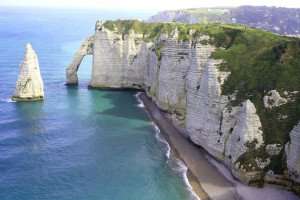 We love all the regions where we offer cooking vacations, but some locations really stand out! Normandy is certainly one of those places, offering amazing regional cuisine, fantastic local food products, and interesting cultural and historical sites. Normandy is perhaps most well-known for its place in military history, but it is its culinary traditions that stand out to us. From its rugged coast that hugs the English channel to the small hamlets that envelope you with local flavor, it is the perfect culinary destination. Normandy’s gastronomic outputs are as unique as its landscapes, with famous products such as Calvados apple brandy, Camembert cheeses, and fresh seafood from the coast. There are so many reasons why you should choose Normandy for your cooking holiday in France, but here is our list of the top five!
We love all the regions where we offer cooking vacations, but some locations really stand out! Normandy is certainly one of those places, offering amazing regional cuisine, fantastic local food products, and interesting cultural and historical sites. Normandy is perhaps most well-known for its place in military history, but it is its culinary traditions that stand out to us. From its rugged coast that hugs the English channel to the small hamlets that envelope you with local flavor, it is the perfect culinary destination. Normandy’s gastronomic outputs are as unique as its landscapes, with famous products such as Calvados apple brandy, Camembert cheeses, and fresh seafood from the coast. There are so many reasons why you should choose Normandy for your cooking holiday in France, but here is our list of the top five!
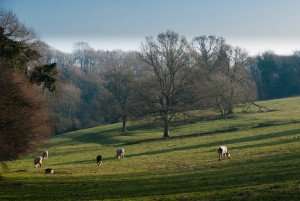 Dairy Products
Dairy ProductsNormandy boasts an abundance of exquisite cheeses, butter, and cream, and you may think us biased, but we consider outstanding dairy alone to be a compelling reason to explore any locale. A key player in French gastronomy, and the reason for putting Normandy’s dairy on the map, is the Normandy cow. No other region of France has dedicated more land to its pastoral champions. Normandy cows were imported to the region by vikings and have worked hard ever since to meet the needs of northwestern France, the region of the country most famous for its milk products. Normandy cows work hard, producing everything from fresh milk and cream, to butter and cheese. In fact, the term ‘à la Normande’ in French means ‘a creamy or buttery sauce’, although it is occasionally used in reference to its apple products like cider and Calvados.
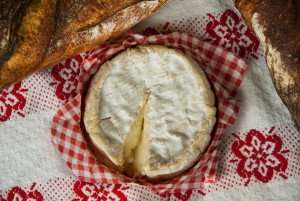 Among these treasures, the renowned Camembert cheese holds the prestigious AOP designation, confirming its status as a Protected Designation of Origin. This classification ensures that the cheese is produced according to tradition in the designated geographical area, safeguarding its authenticity. Other notable Normandy cheeses such as Livarot, Pont-L’Evêque, and Le Neufchâtel also bear the AOP label, which signifies their adherence to regional traditions and quality control. The AOP designation serves to emphasize the significance of these cheeses to preserving the rich cultural and culinary heritage of Normandy.
Among these treasures, the renowned Camembert cheese holds the prestigious AOP designation, confirming its status as a Protected Designation of Origin. This classification ensures that the cheese is produced according to tradition in the designated geographical area, safeguarding its authenticity. Other notable Normandy cheeses such as Livarot, Pont-L’Evêque, and Le Neufchâtel also bear the AOP label, which signifies their adherence to regional traditions and quality control. The AOP designation serves to emphasize the significance of these cheeses to preserving the rich cultural and culinary heritage of Normandy.
Normandy’s dairy products and fresh fruit are the pride of the region, and much celebrated by locals and tourists alike.
Learn more about French cheeses.
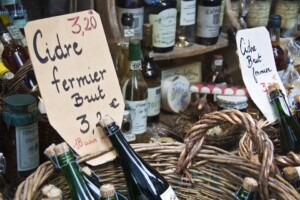 Apple Cider and Apple Brandy
Apple Cider and Apple BrandyAlthough Normandy dedicates much of its real estate to its dairy farms, it is also populated with miles and miles of apple orchards. While the rest of France is preoccupied with wine production, Normandy is busy mastering its libations of choice, cider and Calvados. Calvados is an Apple-brandy, although the Normans refer to it as “eau-de-vie”, the water of life! The spirit known locally as “calva” is concocted from local apple varieties that have been fermented into a dry cider- another tasty regional specialty- then distilled and aged in oak casks. The liquor is aged for a minimum of two years before it is packaged and sold. This smooth liquor is most popularly enjoyed either as an aperitif before a meal, or as a digestif during or after a meal.
Normandy cider is nothing like the thin apple juice or sweet apple cider one might find at fall fairs in the Midwest. It is a hard cider, and its taste can run from the very light and fruity to the unusual and funky. Norman ciders are best paired with a regional sheep’s milk cheese.
Learn more about the history of Normandy.
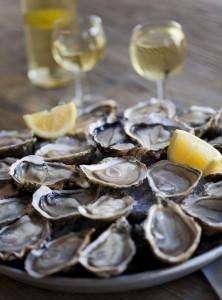 Oysters
OystersDespite its hundreds of miles of coastland, Normandy is most famous for its meat, particularly beef, lamb, and duck. However, it would be impossible not to acknowledge Normandy’s oysters. Normandy’s Cotentine peninsula is also called Cherbourg, and it is one of the major oyster producers in France. Their oyster production is only matched by the fame Huîtres de Pleine mer.
The region’s extensive coastline promises seafood that is plentiful and fresh. The icy Atlantic waters provide the ideal breeding conditions for clams, mussels, scallops, and oysters. There are many local delicacies worth trying, such as Marmite Dieppoise, a fish stew traditional to Dieppe, made from a medley of fish, crustaceans, and mollusks. A Coquille St Jacques is another excellent seafood dish, featuring scallops served on the shell, alongside shrimp and mussels, with a gratin on top.
Mont Saint-Michel and its deadly tides feature prominently in Adam Gidwitz’s novel The Inquisitor’s Tale.
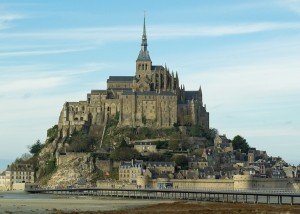 Mont Saint-Michel
Mont Saint-MichelAnother highlight you can visit while in Normandy is one of France’s most famous tourist sights, the stunning Mont Saint-Michel, an austere Romanesque abbey. It is located at the border of Normandy and Brittany atop a small island, at the mouth of the Couesnon river that runs into the English Channel. The Abbaye du Saint Michel is a truly remarkable architectural feat, positioned to be surrounded by sea when the tide is high and sand when the tide is low. The unruly channel surrounded by rocky mountains towering into a misty sky creates a stunning backdrop to the abbey’s already imposing presence. It is one of France’s most-toured landmarks outside of the popular Parisian destinations. Due to its relatively short distance from the area, many travelers to Normandy make time for an excursion to this unforgettable location.
The Mont Saint Michel is a UNESCO World Heritage Site that still holds communes of religious orders. The chants of resident monks and nuns can be heard during mass, creating an atmosphere of surrealism that imbues one with a sense of timelessness. The abbey has been a major site for Christian pilgrimage since well before becoming one of the most visited sites in France. Despite the thousands of visitors, less than 50 people reside on the island.
The location was also the inspiration for Peter Jackson’s Minas Tirith in the Lord of the Rings trilogy. The Mont Saint-Michel and its deadly tides also feature prominently in Adam Gidwitz’s novel, The Inquisitor’s Tale.
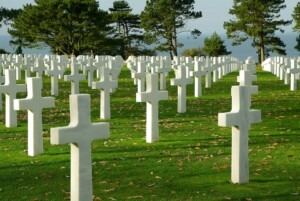 A visit to Normandy wouldn’t be complete without visiting the site of one of the most significant military events in world history. This year will mark the 80th anniversary of the D-Day landing of the Allied forces in June of 1944. Thousands of Allied soldiers died, but the battle struck a blow to the Axis powers that was crucial to the Allies’ victory.
A visit to Normandy wouldn’t be complete without visiting the site of one of the most significant military events in world history. This year will mark the 80th anniversary of the D-Day landing of the Allied forces in June of 1944. Thousands of Allied soldiers died, but the battle struck a blow to the Axis powers that was crucial to the Allies’ victory.
They have been honored in the Omaha Beach Memorial, a striking and much celebrated monument of monolithic style. It is accompanied by the Les Braves sculpture, which is a series of large, wing-like spikes of metal, set close to the water so that they appear to be swimming or flying. The statue signifies hope, liberty, and fraternity, in recognition of the sacrifice made by those fallen soldiers.
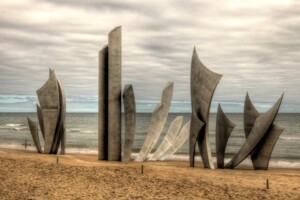 Normandy’s military history has actually played a huge role in the division of power and politics in the region for centuries. The Norman Conquest in 1066 was the impetus for the institution of a feudal system in England, and would permanently intertwine the French with the English in terms of land ownership, language, and politics. This connection would affect their historical trajectory right up to the present day.
Normandy’s military history has actually played a huge role in the division of power and politics in the region for centuries. The Norman Conquest in 1066 was the impetus for the institution of a feudal system in England, and would permanently intertwine the French with the English in terms of land ownership, language, and politics. This connection would affect their historical trajectory right up to the present day.
Normandy’s military history is well documented in its many museums, where visitors are offered a myriad of interactive ways to engage with the past. For instance, in Bayeux, one can see the Bayeux Tapestry: an intricate, 68-metre long work of art depicting events beginning as early as the Battle of Hastings, and leading all the way up to the Norman Conquest.
Another site commemorating those who died in service to the Allies is the American cemetery at Colleville-sur-Mer. The cemetery offers an intensely moving experience for persons of any nationality, and is a must-see visit for anyone interested in history.
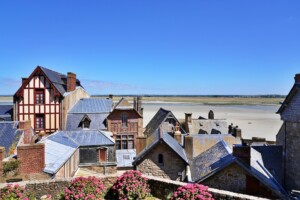 In the coastal towns where these monuments are located, one may even come across locals who lived through these historical events and are willing to tell their stories. There is no historian’s account that could compare to that of an eyewitness.
In the coastal towns where these monuments are located, one may even come across locals who lived through these historical events and are willing to tell their stories. There is no historian’s account that could compare to that of an eyewitness.
The memory of this tragic period of world history has been given new life through the power of Normandy’s rich cultural offerings of museums and monuments. Despite its long history of militarism, Normandy honors its past by perpetuating a culture of peace, liberty, and reconciliation. The 80th anniversary of D-Day is an opportunity to celebrate Normandy’s present peace and prosperity, while emphasizing a spirit of hope for the future.
Normandy is plentiful in tourist attractions, and can keep any visitor entertained for days. The somber reminders of war are tempered by the beautiful architecture and rich cultural outpourings. Only here in Normandy can a simple cow or apple humble one with its beauty and quality to the same extent as the formidable Mont Saint-Michele. Nowhere else can compare to its cozy small towns and charming locals, whose cuisine is unprecedented in style and excellence. Normandy is your chance to see France at its friendliest!
Visit Normandy on our newest cooking vacation in France, our French Farmhouse Cooking Vacation in Normandy.
By Peg Kern
Try these recipes from Normandy:
Sign up to receive our newsletter, which includes travel tips, recipes, promotions, and information on our best cooking vacations.
Find more photos, videos, food facts, and travel stories from The International Kitchen on Facebook, Instagram, and YouTube.